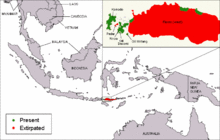The eruption of toba
Main article: Toba catastrophe theory
The Toba eruption (the Toba event) occurred at what is now Lake Toba about 67,500 to 75,500 years ago. The Toba eruption was the latest of a series of at least three caldera-forming eruptions which have occurred at the volcano, with earlier calderas having formed around 700,000 and 840,000 years ago. The last eruption had an estimated Volcanic Explosivity Index of 8 (described as "mega-colossal"), making it possibly the largest explosive volcanic eruption within the last 25 million years.Bill Rose and Craig Chesner of Michigan Technological University have deduced that the total amount of erupted material was about 2,800 km3 (670 cu mi)—around 2,000 km3 (480 cu mi) of ignimbrite that flowed over the ground, and around 800 km3 (190 cu mi) that fell as ash, with the wind blowing most of it to the west. The pyroclastic flows of the eruption destroyed an area of 20,000 square kilometres (7,722 sq mi), with ash deposits as thick as 600 metres (1,969 ft) by the main vent.
To give an idea of its magnitude, consider that although the eruption took place in Indonesia, it deposited an ash layer approximately 15 cm (5.9 in) thick over the entire South Asia; at one site in central India, the Toba ash layer today is up to 6 m (20 ft) thick and parts of Malaysia were covered with 9 m (30 ft) of ashfallIn addition it has been variously calculated that 10,000 million metric tons of sulphuric acid or 6,000 million tons of sulphur dioxide were ejected into the atmosphere by the event, causing acid rain fallout.
The Toba caldera is the only supervolcano in existence that can be described as Yellowstone's "bigger" sister. With 2,800 km3 (670 cu mi) of ejecta, it was an even greater eruption than the supereruption (2,500 km3) of 2.1 million years ago that created the Island Park Caldera in Idaho, USA. The eruption was also about three times the size of the latest Yellowstone eruption of Lava Creek 630,000 years ago. For further comparison, the largest volcanic eruption in historic times, in 1815 at Mount Tambora (Indonesia), ejected the equivalent of around 100 km3 (24 cu mi) of dense rock and made 1816 the "Year Without a Summer" in the whole northern hemisphere, whilst the 1980 eruption of Mount St. Helens in Washington State ejected around 1.2 km3 (0.29 cu mi) of material. The largest known eruption since the Toba event, the Oruanui eruption in New Zealand around 24,500 BC, ejected the equivalent of 530 km3 of magma.
The subsequent collapse formed a caldera that, after filling with water, created Lake Toba. The island in the center of the lake is formed by a resurgent dome.

Landsat photo of Sumatra surrounding Lake Toba
There is some evidence, based on mitochondrial DNA, that the human species may have passed through a genetic bottleneck around this time, reducing genetic diversity below what would be expected from the age of the species. According to the Toba catastrophe theory proposed by Stanley H. Ambrose of the University of Illinois at Urbana-Champaign in 1998, human populations may have been reduced to only a few tens of thousands of individuals by the Toba eruption.
[edit] More recent activity
Smaller eruptions have occurred at Toba since. The small cone of Pusukbukit has formed on the southwestern margin of the caldera and lava domes. The most recent eruption may have been at Tandukbenua on the northwestern caldera edge, since the present lack of vegetation could be due to an eruption within the last few hundred years.Some parts of the caldera have experienced uplift due to partial refilling of the magma chamber, for example pushing Samosir Island and the Uluan Peninsula above the surface of the lake. The lake sediments on Samosir Island show that it has been uplifted by at least 450 metres (1,476 ft) since the cataclysmic eruption. Such uplifts are common in very large calderas, apparently due to the upward pressure of unerupted magma. Toba is probably the largest resurgent caldera on Earth. Large earthquakes have occurred in the vicinity of the volcano more recently, notably in 1987 along the southern shore of the lake at a depth of 11 km (6.8 mi). Other earthquakes have occurred in the area in 1892, 1916, and 1920–1922.
Lake Toba lies near the Great Sumatran fault which runs along the centre of Sumatra in the Sumatra Fracture Zone. The volcanoes of Sumatra and Java are part of the Sunda Arc, a result of the northeasterly movement of the Indo-Australian Plate which is sliding under the eastward-moving Eurasian Plate. The subduction zone in this area is very active: the seabed near the west coast of Sumatra has had several major earthquakes since 1995, including the 9.1 2004 Indian Ocean Earthquake and the 8.7 2005 Sumatra earthquake, the epicenters of which were around 300 km (190 mi) from Toba.
On 12 September 2007, a magnitude 8.5 earthquake shook the ground in Sumatra and was felt in the Indonesian capital, Jakarta. The epicenter for this earthquake was not as close as the previous two earthquakes, but it was in the same vicinity.
On 26 October 2010, a magnitude 7.7 earthquake occurred 36 kilometers (22 mi) southwest of the nearby island of Pagai-selatan. A 10-foot (three-meter) tsunami immediately followed the qua




